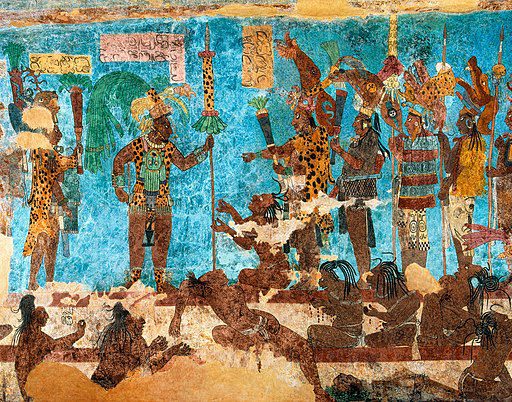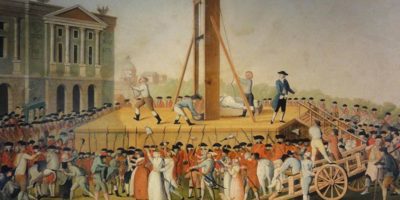Top 20 Remarkable Facts about the Mayans
One of the most developed and complex civilizations in the pre-Columbian era was the ancient Mayan civilization. They created a vast legacy of amazing accomplishments in science, the arts, architecture, and other fields. The Mayans continue to captivate and enthrall historians and fans alike because of their extraordinary astronomical expertise and distinctive writing style. This essay will examine the Top 20 Remarkable facts about the Mayans, including their complex calendar system, magnificent pyramids, profound mathematical knowledge, and unexplained decline. Discover the fascinating world of the earliest Mayans with us as we explore their enduring legacy.
1. Maya Civilization Flourished From 2000 BCE to 1500 CE

Mayan mural from Bonampak. ENRICO FERORELLI, DOUG STERN, Public domain, via Wikimedia Commons
Perhaps the most well-known of america’s ancient civilizations was the Maya. Around 2600 B.C., they emerged in the Yucatán and gained popularity throughout what is now southern Mexico, Guatemala, northern Belize, and western Honduras.
2. Maya Civilization Achieved Significant Accomplishments In Architecture, Mathematics, Astronomy, and Writing
Historians believe that Maya civilization was one of the earliest and most developed civilizations in the Americas, about two thousand years ago. They were an industrious people and are known to have developed a written language using hieroglyphs and interestingly are the pioneers of zero in mathematics. They are also renowned to have developed an intricate and exact calendar system thanks to their knowledge of mathematics and astronomy. We owe them for giving us the calendar that we are using today.
3. Mayan Cities Were Highly Organized And Consisted Of Many Structures

Dzecilná ruins Campeche 1887. Teoberto Maler, Public domain, via Wikimedia Commons
4. Mayan Cities Were Highly Organized And Consisted Of Many Structures
Mayan cities were regarded as highly organized with array of beautiful platforms that were complimented by masonry buildings. There were different structures ranging from massive temple pyramids and palaces to small homes that stood close to one another. Each of these buildings was placed around a large courtyard or square.
4. The Mayans Built Cities Around Cenotes, Which Were Sacred To Them

Mayans 1. Tony Hisgett from Birmingham, UK, CC BY 2.0, via Wikimedia Commons
Cities, including the well-known Chichen Itza, were constructed around these natural wells because major Maya towns needed easy access to sufficient water supplies. Numerous cenotes, including the Sacred Cenote in Chichen Itza, were significant sites for Maya rituals. The deity of rain, Chaac, was said to reside at the bottom of these sacred wells, and the Maya regarded cenotes to be an entrance to Xibalba, the underworld.
The liminal areas known as cenotes, which acted as crucial gateways between the terrestrial world and the aquatic underworld, were fundamental to Maya mythology. The dead passed through this opening, and both humans and gods were born again from it.
5. Mayan Hieroglyphs Were A Fully Developed Pre-Columbian Writing System
For the most part because to its outstanding beauty and partial decipherment, the Maya script is regarded as the most advanced Mesoamerican writing system. Syllable signs and logograms are mixed in Maya writing.
More than 800 symbols, including some hieroglyphs and other phonetic marks for syllables, make up the Mayan writing system. The hieroglyphic signs portray animals, humans, and everyday items and are pictorial, that is, they are recognized images of actual objects.
6. The Mayans Believed That The World Had Been Destroyed And Recreated
The ancient Maya conceived in terms of eras that lasted roughly 5,200 years in modern time and held the belief that creation and destruction occur in cyclical patterns. According to the Maya, the current cycle started either in 3114 B.C. or 3113 B.C. on our calendar and is predicted to terminate in either A.D. 2011 or 2012.
7. Mayan Art Depicted Gods, Animals, And Everyday Life
Maya sculptures and decorations were made of stone, wood, clay, and stucco. Beautiful jewelry and carvings were created from materials like wood, obsidian, jade, bone, shells, and stones. Murals, reliefs, and jars made of slippery pottery featured action scenes. Molds, statuettes, ruler portraits, and other creations by artists.
With the aid of stone tools and limestone or volcanic tuff, sculptors created lifelike portraits of celestial lords, courtly ladies, prisoners, and deities. Stone movable items were another major focus of the labor-intensive Maya sculptors.
8. The Mayans Developed Advanced Agricultural Techniques To Manage Their Resources
The Mayan people lived in a land of rugged hillsides, bogs, and rain forests that required tremendous expertise to cultivate. The Maya were masters in creating sophisticated farming and agricultural technologies, such as raised bed farming, terracing, and irrigation.
9. The Mayans Had A Complex Social Hierarchy With Priests And Nobles At The Top
The Mayan social hierarchy system allowed for clear differentiation among nobility, commoners, serfs, and slaves in Maya society. Nobles belonged to a sophisticated, specialized class. Elite family lines were employed to pass down a noble’s rank and their chosen line of work.
10. Mayan Society Was Divided Into City-States With Their Own Rulers

Mayan. Nick Bradshaw from London, UK, CC BY-SA 2.0, via Wikimedia Commons
The Maya, on the other hand, lived in independent political states that were connected to one another by commerce, ties to certain political groups, and paying tribute. These states included both independent and those that belonged to broader political structures. Simple chiefdoms were initially in charge of the Maya states.
11. The Mayans Used Human Sacrifice To Worship Their Gods
Animals and people were occasionally sacrificed during the festivals in order to appease the gods. The Mayans regularly offered sacrifices to iguanas, turtles, crocodiles, dogs, jaguars, and turkeys. However, the ultimate sacrifice was made—humans.
12. The Mayans Believed In An Afterlife And Buried Their Dead With Offerings
Death was not the end of life for the ancient Maya; rather, the soul was transferred to the Underworld (referred to as Metnal by the Yucatecans and Xibalba by the Quichés).
13. Mayan Music Was Played On Drums, Flutes, And Trumpets

Trumpet. Photo by Chris Bair on Unsplash
The Maya employed music to accompany funerals, festivals, and other rites. They used instruments like trumpets, flutes, whistles, and drums.
14. The Mayans Developed A Zero And Positional Numeral System

Zero. Photo by Peter Burdon on Unsplash
The most advanced mathematical system to be created in the Americas was Maya mathematics. Three symbols were all that were needed for the Maya counting system: a dot for one, a bar for five, and a shell for zero. These three symbols were employed in a variety of ways to keep track of past and future calendar events and to enable even those without formal education to perform the basic mathematical operations required for trade and commerce. It is amazing that the Maya grasped the value of zero when the majority of civilizations at the time did not.
15. The Mayans Played A Ball Game That Had Religious Significance
Pitz, an ancient Maya ballgame, played a role in social, religious, and political life. Players would try to bounce the rubber ball through stone hoops that were mounted to the sides of the ball court without using their hands. The rubber ball size ranged from that of a softball to a soccer ball.
16. Mayan Language Still Spoken In 6 million Countries
There are 32 Mayan languages descended from Yucatec Maya, and over 5 million people speak them from the Yucatan Peninsula to Chiapas, as well as in Belize, Guatemala, and Honduras. The Maya language is still alive today. At least 6 million Maya people, mostly in Guatemala, Mexico, Belize, El Salvador, and Honduras, speak Mayan languages.
17. The Mayans Had A Complex System Of Trade And Commerce
The Maya used a barter system, like other civilizations from this era, to conduct commerce and business. They exchanged items like corn, tobacco, textiles, trinkets, and even feathers. The utilization of cacao beans by the Mayans brought them the closest to contemporary money.
18. The Maya were a polytheistic people
The Maya were a polytheistic people. They frequently offered sacrifices by covering their bodies in intricate tattoos to appease their gods. The gods that the Maya people adored are depicted in their tattoos, along with strong animals.
19. They Were Highly Innovative people

Calendar. Photo by Maddi Bazzocco on Unsplash
One of the most well developed civilizations in the Americas was created by the ancient Maya two thousand years ago. They created a written language using hieroglyphs and created the idea of zero in mathematics. The Maya created an intricate and exact calendar system thanks to their knowledge of mathematics and astronomy.
20. The Mayans Used Tattooing And Body Piercing To Express Themselves

Tattoo. Photo by Allef Vinicius on Unsplash
Body alterations became extremely popular in American culture in the 20th century, yet the Maya had been using them for generations before we accepted them into our own culture. The Maya viewed physical alterations as signs of power, expressions of their spirituality and religion, and indicators of social standing. They thought that undergoing painful body alterations would satisfy their gods and help them rise to higher rank. Let’s analyze some of the bodily modifications shown in the touring exhibit Maya: Hidden Worlds Revealed from the Connecticut Science Center to see what made them special and perhaps draw some parallels to our own alterations.
This article has demonstrated how brilliant and innovative these people were. They played a leading role in science, agriculture, art, and mathematics. Their legacy is still felt up to today.
Planning a trip to Paris ? Get ready !
These are Amazon’s best-selling travel products that you may need for coming to Paris.
Bookstore
- The best travel book : Rick Steves – Paris 2023 – Learn more here
- Fodor’s Paris 2024 – Learn more here
Travel Gear
- Venture Pal Lightweight Backpack – Learn more here
- Samsonite Winfield 2 28″ Luggage – Learn more here
- Swig Savvy’s Stainless Steel Insulated Water Bottle – Learn more here
Check Amazon’s best-seller list for the most popular travel accessories. We sometimes read this list just to find out what new travel products people are buying.









